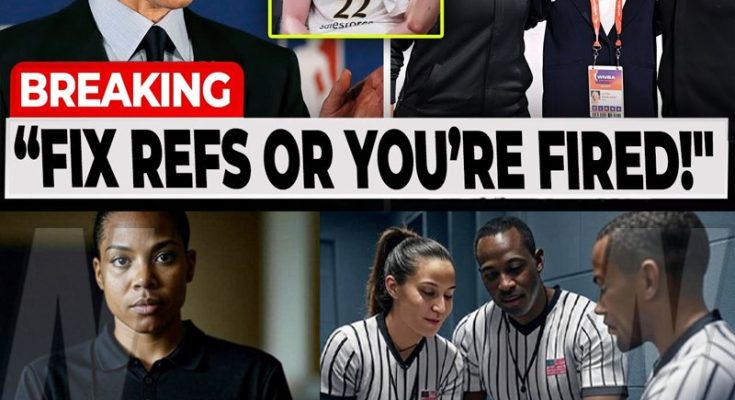The WNBA Faces a Crisis of Credibility Amid Mounting Officiating Controversy
What was billed as a milestone moment for the WNBA—an anticipated matchup between rookies Caitlin Clark and Paige Bueckers that drew more than 2.1 million viewers—has instead become a flashpoint for widespread criticism of the league’s officiating, player safety protocols, and leadership.
With unprecedented viewership, rising star power, and momentum on its side, the WNBA entered the 2025 season poised for a breakthrough. However, instead of capitalizing on this attention, the league now finds itself under intense scrutiny after a series of nationally televised games highlighted what many see as systemic failures in officiating and player protection.
A Showcase Marred by Inconsistency
The recent Clark–Bueckers matchup was expected to be a defining event in the WNBA’s narrative—a celebration of its most promising rookies and a testament to its growing popularity. Yet, the focus quickly shifted from on-court talent to what viewers, analysts, and players described as erratic and excessive physicality permitted by referees.
During the broadcast, ESPN commentators Rebecca Lobo and Ryan Ruocco openly expressed concern over the officiating. “There’s a hold. There’s another grab. There’s a grab. There’s a hold. Every possession,” Lobo observed. The commentary went viral, symbolizing growing frustration among players and fans alike.
At the center of the controversy is Caitlin Clark, the top overall pick and face of the league’s current growth. Clark has repeatedly endured physical, often unchecked contact during games—a sharp contrast from her collegiate career, where she never missed time due to injury. Now, just months into her rookie season, she has already been sidelined by injury.

An Escalating Pattern of Concern
Insiders have pointed to a culture shift within the WNBA, where physical play has not only been tolerated but in some cases encouraged. Rebecca Lobo has reported that certain coaches are instructing players to use physicality to disrupt opponents, knowing officials are unlikely to call fouls consistently.
Paige Bueckers herself recently remarked that she had to “relearn how to foul” in the WNBA, suggesting the league’s standard for contact is far more permissive than in previous levels of play. This sentiment, shared by multiple players, raises important questions about whether the rules are being applied consistently and safely.
The impact of this culture extends far beyond entertainment value. The league has reported over 140 injuries midway through the season—a startling figure given that there are just 179 active players on rosters. These statistics have become central to growing media criticism.
Media Backlash and Commissioner Response
Following Clark’s most recent game against the Connecticut Sun—another physical affair that ended with a visible argument between Clark and an official—the Washington Post published a blistering editorial titled, “The WNBA Should Change Its Logo to a Bruise.” The article directly criticized Commissioner Cathy Engelbert and the league for enabling reckless officiating and compromising player health.
In response, Engelbert downplayed the criticism, stating, “No winning team ever complains about officiating.” The remark has since been widely condemned as dismissive and out of touch, particularly as calls for reform grow louder from athletes, media, and fans.

A Pattern in High-Stakes Games
The 2024 WNBA Finals also featured controversial officiating that affected the outcome of the championship. A critical late-game call gave the New York Liberty an opportunity to force overtime, eventually resulting in a title win over the Minnesota Lynx. Minnesota head coach Cheryl Reeve spoke candidly postgame: “Be consistent. It’s not that hard.”
Incidents like this have eroded public trust in officiating integrity, especially when such calls directly impact playoff and championship outcomes.
Declining Viewership, Sponsor Hesitation
While the league enjoyed record-breaking ratings during the early season, recent data shows a sharp decline in viewership—particularly during games where Clark is absent. In some cases, audience numbers have dropped by as much as 50 percent, and arena attendance has also begun to wane.
This downturn raises concerns not only about fan retention but also about the WNBA’s upcoming media rights negotiations and expansion efforts. The league’s momentum is clearly at risk, and its handling of this crisis may shape its trajectory for years to come.
The NBA’s Role and a Call for Accountability
The WNBA operates in close partnership with the NBA, which has provided financial support and strategic infrastructure since the league’s inception. As the WNBA’s commercial viability becomes more closely tied to the star power of players like Clark, the NBA may face increased pressure to ensure that its investment is being properly stewarded.
Protecting star players is not a luxury; it is essential to the health of any professional league. For the WNBA to continue growing, officiating must be consistent, rules must be enforced, and leadership must listen to the concerns of its athletes and fans.
Conclusion
The WNBA stands at a pivotal moment. The current backlash is not rooted in negativity but in deep investment—from fans, players, media, and sponsors who believe in the league’s potential. However, that belief is contingent on a product that is fair, safe, and watchable.
If Commissioner Cathy Engelbert and league officials do not address the ongoing issues with officiating and player safety, they risk undermining the very progress that stars like Caitlin Clark have helped generate.
The opportunity for reform is still within reach. But without swift and meaningful action, the league could forfeit not just public trust, but its future.
Let me know if you’d like this formatted for a specific outlet (e.g., The Athletic, Sports Illustrated, The Ringer), or adapted into a press release or op-ed.

